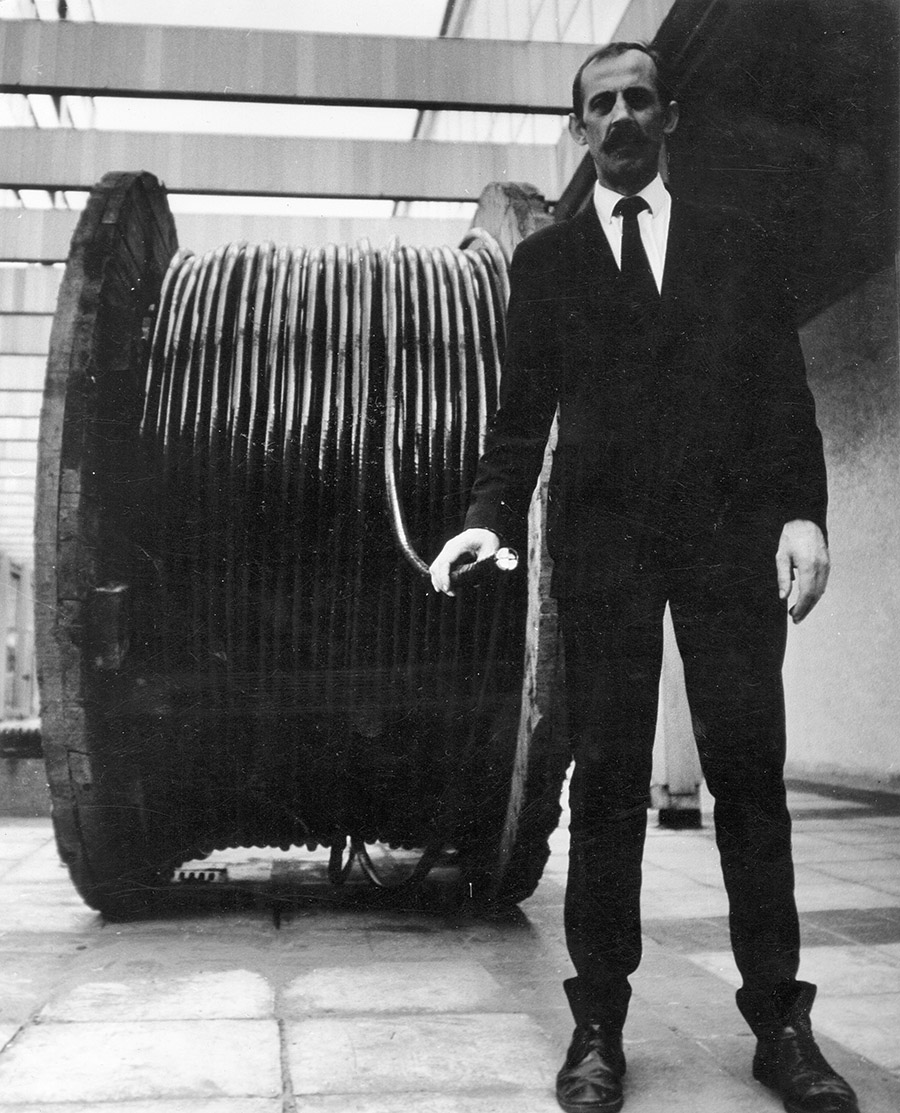Edward Krasiński
Stedelijk Museum, Amsterdam, The Netherlands
Stedelijk Museum, Amsterdam, The Netherlands

‘I place it horizontally at a height of 130 cm everywhere and on everything. With it I encompass everything and go everywhere’, remarked artist Edward Krasiński (1925-2004) of his signature blue Scotch tape, which, since 1968, has traversed bodies, landscapes, the nooks and crannies of private homes and exhibition spaces as well as other artists’ works. The blue stripe roams around four of the eight rooms in his show at the Stedelijk Museum – first presented at Tate Liverpool last year, and the most comprehensive exhibition of the artist’s oeuvre in over a decade.

Although Krasiński has become closely identified with this blue stripe, it was just one of many off-the-shelf materials repurposed in his artworks, which adroitly orchestrate our experience of the spaces they inhabit. By the time he started using the tape, he had abandoned the surrealist erotic imagery he had explored in the 1950s: a marked trend among the pre– and postwar Kraków circles in which he had studied. What remained in his work, however, was a sense of irreverence towards creating objets d'art; one of his aphorisms reads: ‘Art is too serious a thing to be made by artists.’
By the mid-1960s, Krasiński had distilled painting into traces of paint and condensed sculpture to a line. The first room of the exhibition brings together several works, among them Net I (1962) which, while resembling paintings, are objects constructed of wood, mesh and wire, in which colour only highlights their dimensionality. Spear (c.1965) is a gravity-defying horizontal mark cutting across the exhibition’s second room. It comprises a wooden rod, its sharp end severed from its body, surrounded by smaller cylinders scattered in the air like fragments of a space rocket separating after take-off. This is energy and movement in freeze-frame. Behold what avant-garde poet Julian Przyboś hailed ‘the spear of the atomic age’.

This formal dynamism coincided with pivotal moments in Krasiński’s practice including his first solo exhibition, his involvement in founding Warsaw’s Foksal Gallery (1966); and his participation in the 1967 Guggenheim International. When his shipment of works would not arrive in time for the opening of the 1970 Tokyo Biennial he adopted a conceptual stance sending an 80-metre long telex message, to be temporarily displayed as his contribution. The tape consisted of one word: BLUE.
That same year Krasiński moved into the studio of artist Henryk Stażewski, after whose death in 1988, he exhibited sections of the flat in Foksal Gallery in the form of life-size photographs. Concurrently, he started to populate the space with his own works, developing – until shortly before his death – an immersive environment in which all aspects of his practice co-existed through a medley of objects. Reportedly a few saw him working: wire sculptures, tongue-in-cheek trompe l'oeil details (raised tiles, wooden floorboards and artificial mice), spatial interventions (such as white architectural panels with illusionistic 3D shapes painted on them) and photographs quoting other works or places would materialize overnight. All this came complete with blue tape running across the walls.

Babette Mangolte’s film Edward Krasiński’s Studio (2012), shown in the last room of the exhibition, is a meditation on this space. Mostly composed of still, silent shots, in the penultimate sequence the camera shifts from background to foreground and the blue tape on the wall aligns with the blue stripe running around a revolving globe suspended from the ceiling set in motion by an invisible hand. This is followed by a wide shot of the globe, now just one amongst many fixtures in the flat – an apt coda for Krasiński’s craving to leave his trace marked by flippancy. Between a sardonic conjurer and a deadpan jester, he was a sleight-of-hand-artist, and a rare one at that.
Main image: Edward Krasiński, installation view, Stedelijk Museum, Amsterdam, 2017. Courtesy: Stedelijk Museum; photograph: Gert Jan van Rooij
























